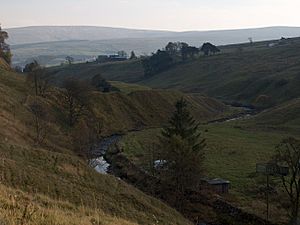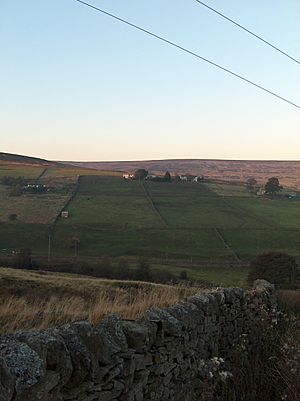Weardale facts for kids
Weardale is a beautiful valley, also called a dale, located in County Durham, England. It sits on the eastern side of the Pennines, which are often called the "backbone of England." A large part of Weardale is inside the North Pennines Area of Outstanding Natural Beauty (AONB). This means it's a special place with amazing landscapes and wildlife, protected for everyone to enjoy. The upper part of the valley has high hills called fells and wide areas of heather where grouse birds live. The River Wear flows through Weardale, passing through towns like Bishop Auckland and Durham, before reaching the sea at Sunderland.
Weardale has several important towns and villages. These include St John's Chapel, and the towns of Crook, Stanhope, and Wolsingham.
Contents
Weardale's Weather
Weardale is known for its cold and snowy winters. In the past, winters were very harsh and lasted a long time, with lots of snow. Today, people sometimes take advantage of the snow for skiing at a place called Swinhope Head.
Amazing Wildlife and Plants
Weardale is home to many interesting animals and plants.
Local Wildlife
You can find an important group of black grouse birds here, along with other birds that live in the uplands. The River Wear is a home for sea-trout and salmon. Sometimes, you might even see adders (a type of snake) on the open moors.
Unique Plants
Weardale also has some special plants. You can still find meadows full of different plant species. In summer, it's easy to spot the wood cranesbill (Geranium sylvaticum) and meadow cranesbill (G. pratense). The mountain pansy (Viola lutea) is a common plant in the shorter grass of the upper valley. In late spring, damp areas in the upper valley are bright with yellow marsh marigolds. A tiny but pretty plant called spring sandwort (Minuartia verna) grows around old lead mines. It can grow there because it's not bothered by the lead in the soil, unlike other plants.
Weardale's Rich History
People have lived and worked in Weardale for a very long time. We know this from many clues they left behind.
Ancient Discoveries
For example, the Heatheryburn Bronze Age collection, which includes gold objects, was found here and is now in the British Museum. Roman officers also visited Weardale for hunting trips and left altars behind. A special black stone called "Frosterley Marble," which has fossils in it, has been used since Norman times to decorate important buildings like Durham Cathedral.
Early Settlements and Farming
The towns of Stanhope and Wolsingham were likely Anglo-Saxon villages even before the Normans arrived in 1066. The Normans expanded farming in the valley. Later, in the Middle Ages, the upper valley was cleared to create vaccaries, which were farms for raising cattle. The Bishops of Durham owned the rights to all the minerals in the area. They kept these rights for as long as the lead mining industry was active, and miners had to lease the land from them.
The Weardale Campaign
In 1327, King Edward III led his first military campaign in Weardale. This was called the Weardale campaign, and it was against the Scots. Even though it wasn't a military success, it led to an important peace agreement called the Treaty of Edinburgh–Northampton. A writer named Jean Le Bel, who was there, wrote a detailed description of the campaign.
The Rise of Methodism
In the 1700s, John Wesley, who started the Methodist movement, visited Weardale many times. Because of his visits, the valley became a strong center for Methodism. High House Chapel near Ireshopeburn is said to be the Methodist chapel that has been used continuously for the longest time in the world. It also houses the Weardale Museum, which has a special room dedicated to Methodism and John Wesley.
Inspiration for Writers
The poet W. H. Auden spent time in Weardale when he was young, between the two World Wars. He loved the wild countryside and the old lead mining sites. These places became a source of inspiration for his writing throughout his life. One place he visited, Rookhope, is also the setting for an old song called "The Rookhope Ryde." This song tells the story of how men from Weardale fought off cattle-raiders from the Roman wall area in 1569. More recently, Helen Cannam's book "The Last Ballad" is an exciting historical novel set in the valley in the early 1800s.
Weardale's Mining Past
Weardale was once very important for lead mining. You can learn all about it at the Killhope (pronounced "Killup") museum, which even has a preserved mine you can explore.
Early Mining Days
The first records of mining in this part of England date back to the 1100s. At that time, Weardale was a forest owned by the Bishops of Durham, who used it for hunting. The villages of Eastgate and Westgate were once the entrances to this forest.
The Peak of Lead Mining
Lead mining in Weardale was busiest during the 1700s and 1800s. Big companies like the London Lead and Beaumont Companies controlled most of the mining, for example, at the Cornish Hush Mine. However, by the 1880s, lead prices dropped, forcing these companies to leave. The Weardale Lead Company continued mining until 1931. At its peak in the 1800s, there were 28 different lead smelting operations (places where lead was separated from rock) in the region. But by 1919, the last major mine had closed.
Other Minerals
Besides lead, miners also found silver and fluorspar in Weardale. Large amounts of ironstone were also dug up, especially from the Rookhope area. This ironstone was sent to ironworks in places like Consett during the Industrial Revolution. Other minerals like Ganister (a hard sandstone) and dolerite (a type of rock) were also quarried in Weardale.
Miners and Their Journeys
The lead mining industry caused many people to move to and from Weardale. Miners from Cornwall, who were used to tin-mining, came to work in the Pennine mines. Later, many people left Weardale for better-paying jobs in coal mines in the North East or moved to the New World (America and Canada).
The Story of Fluorspar
A valuable by-product of lead mining was fluorspar, which is a beautiful, colorful crystal. For a long time, people didn't know what to use it for. But in the late 1800s, they discovered it could be used in making steel and also in creating non-stick frying pans and other products. Fluorspar is not a precious gem, but collectors highly value fine samples. The fluorspar from Weardale is special because it glows with a bluish light under ultraviolet light. This glowing effect is called fluorescence, and the word itself comes from fluorspar! Collectors consider Weardale fluorspar to be some of the best and most valuable in the world. Mines like Frazers Hush, Boltsburn, and Groverake are famous for their amazing fluorspar crystals. Until 2016, some of the best green fluorspar was found at Rogerley Mine. Now, the nearby Diana Maria Mine also produces beautiful green and sometimes purple fluorspar.
Killhope Lead Mining Museum
The North of England Lead Mining Museum at Killhope has a huge working water wheel called the Killhope Wheel. This wheel was built in the 1870s to power machines that crushed rock to separate the lead ore. The museum also shows off a wonderful collection of local minerals and "spar boxes." These are display cases made by miners to show off the crystals they found themselves.
Weardale's Economy Today
After the lead mines closed, there were not many jobs left in the upper part of Weardale.
Quarrying and Farming
However, in the lower valley around Stanhope and Frosterley, limestone was quarried on a large scale starting in the 1840s. Trains helped carry this limestone to places like Teesside and Consett to be used in making iron and steel. Limestone quarrying continued for many years. Today, the main industry in Weardale is cattle and sheep farming. Only one mine, the Rogerley Mine, is still active on a very small scale, looking for mineral specimens.
Railways and Transport
Weardale once had a railway line that went all the way to Wearhead. It opened in stages between 1847 and 1895. However, parts of the line closed between 1961 and 1968 as the lead industry declined. The remaining line stayed open for cement transport and special train trips until 1993. After that, the Weardale Railway took it over. Passenger services started again briefly in 2004 and then in 2006 under new ownership. The line between Bishop Auckland and Wolsingham reopened in May 2010. Today, you can find both old-fashioned heritage trains (steam and diesel) and local community railbus services.
There is also a regular bus service from Monday to Saturday, provided by Weardale Motor Services. It runs from Bishop Auckland and Crook to Cowshill, at the very top of the valley. At certain times of the year, you might even be able to take the bus further to the Killhope Lead Mining Museum.
Tourism in Weardale
Weardale has a growing tourism industry. You can find places to stay like inns, hotels, bed and breakfasts, and self-catering cottages. There are also some caravan sites. The area offers great opportunities for activities like pony-trekking, mountain biking, and especially walking.
|




